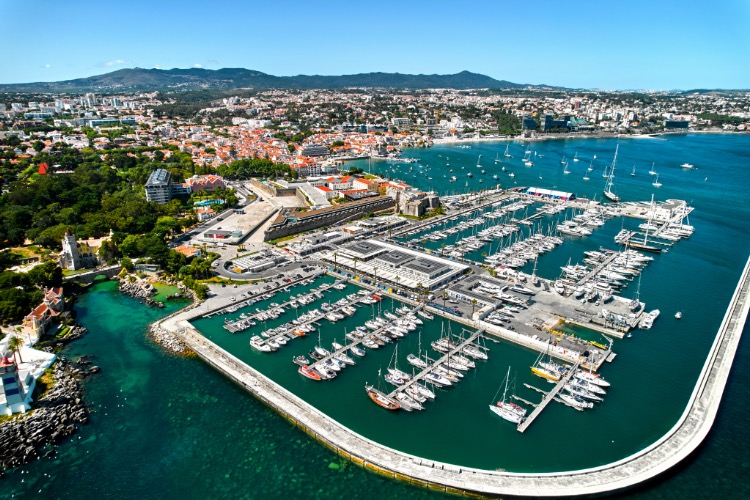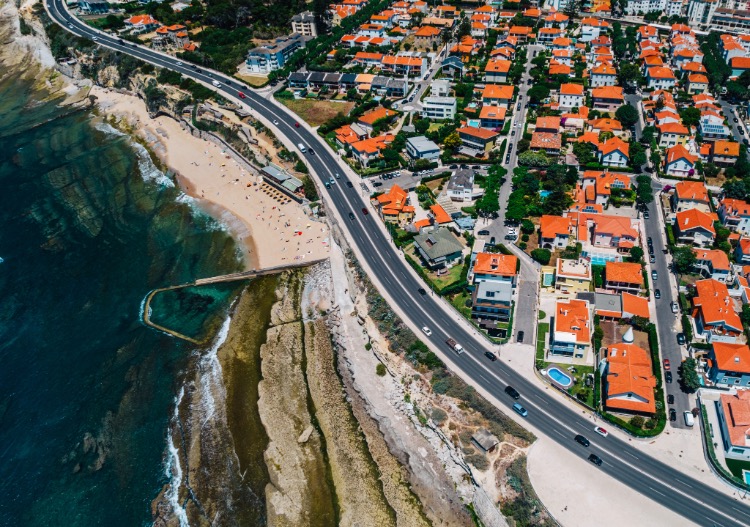Discover the coastal beauty of Cascais, explore the stunning Boca do Inferno cliffs, admire the charming historic center, and enjoy the historical heritage with a perfect natural background.
Intro
For Lisbon tourists, a trip to Cascais is a great way to enjoy the beauty of coastal Portugal. In the past, the city was a simple fishing village that supplied Lisbon with seafood. Nowadays, due to its proximity to the capital, Cascais became a favorite holiday destination for the monarchy at the end of the 19th century. It is an ideal day trip from Lisbon, especially if you want to relax and wander around, enjoying the manicured streets and exquisite architecture.

To get to Cascais, you can take a train from Cais do Sodre station in Lisbon, which takes approximately 40 minutes, or use one of our group tours from Lisbon. Enjoy the colorful historical center, a beautiful promenade with yachts, all kinds of restaurants and cafes, and stunning beaches.

Museum of the Counts of Castro Guimaraes
The palace was built in a romantic style at the end of the 19th century for the Irish aristocrat George O'Neill. However, after his bankruptcy, it was transferred to the banker, Count Castro of Guimaraes. In 1930, it became a historical museum. The museum houses a collection of artifacts that reflect the history and culture of Cascais, including paintings, sculptures, and historical documents.
In addition to visiting the museum itself, you can enjoy the beautiful English-style gardens and even visit a small zoo. The house's interior is a separate work of art, and the beautiful music room and library attract special attention.
Insider Tip: The museum is wheelchair accessible, with ramps and elevators available.
Location: Av Rei Umberto II de Itália Parque Marecha Carmona, 2750-319 Cascais, Portugal
Citadel of Cascais
A small medieval fortress, the Citadel of Cascais, was built in the 15th century, a testament to the city's rich history. Despite its inability to repel the attack of Spanish troops, the fortress was rebuilt during the reign of Portuguese king Philip I, becoming a typical citadel of the Renaissance style, a symbol of resilience and strength.
Today, the Citadel also retains its role as the president's summer residence. In the garden, a small open-air artillery museum is open to visitors.
The Citadel has an art hotel, galleries, and cafes. Its displays include interactive installations and modern sculptures.
Insider Tip: One of the presidential residences is the Palace of the Citadel of Cascais, a formerly royal summer palace also located here and open to visitors.
Location: Av. Dom Carlos I 246, 2750-310 Cascais, Portugal
Santa Marta Lighthouse
Behind the fortress is another beautiful cove—the Santa Marta observation deck (Miradouro de Santa Marta), which has a blue lighthouse lined with azulejos. Inside, there is a museum.
You will meet a 20-meter lighthouse just on the way to the Devil's Mouth. Take your time passing by.
Inside the lighthouse is a small museum dedicated to the 500-year history of Portuguese lighthouses. At the top, there is a good observation deck overlooking the ocean. The best part is that admission is free.
Insider Tip: Please note that, because of the observation deck’s limited capacity, it’s recommended that you make a reservation in advance.
Location: Praceta Farol, 2750-642 Cascais, Portugal
Museum of the Sea
This museum received the name of its founder, King Carlos I, in 1997, who was fond of sports and oceanography. In 1976, the building became the property of the local municipality, and a museum began to operate in it.
The museum has permanent exhibitions dedicated to fishing, navigation, underwater archaeology, ordinary and pleasure ships, and King Carlos I. The Maritime Museum attracts visitors with an exhibition dedicated to fishing and the history of the city; in addition, it displays a rich collection of ocean animals: shellfish, fish, mammals and birds.
Insider Tip: Buy tickets in advance online to avoid lines and save time.
Location: R. Júlio Pereira de Mello, 2750-319 Cascais, Portugal
Rua Frederico Arouca
The shopping street is decorated with black-and-white Portuguese paving. Many shops and restaurants are here, but prices are mostly above average.
Outwardly, it resembles Portugal and coastal Great Britain. This is because Cascais is one of Britain's favorite holiday destinations. When visiting, it's important to respect the local customs and traditions, such as greeting people with a handshake when receiving something.
This part of Cascais is very popular among tourists from more prosperous European countries and is always full of them, but it is also bright and cheerful.
The central square, decorated with black-and-white wave paving, is home to a pretty building with bells from the early 19th century.
Insider Tip: If you want to save money, don’t eat here; going to a less touristic place is better.
Location: R. Frederico Arouca, 2750-642 Cascais, Portugal
Old Town of Cascais
The old town in Cascais is relatively small, like the quarter near the railway station. As you enter, you will see an archway leading to a patio.
This patio is a historical site. A sign on one of the houses says that the Cascais Castle once stood, where the city authorities met, but nothing remains of it now.
After passing through the patio and continuing straight, the street leads to the well-preserved historical landmark—the Cascais fortress.
Insider Tip: Taste some local seafood cuisine at nearby restaurants.
Location: Av. Dom Carlos I 246, 2750-642 Cascais, Portugal
Rock of Boca do Inferno
During a storm, you can watch a fascinating spectacle here. The waves beat from the rock all around, raising water and making a terrible noise, and a dark gap in the cave is a fascinating sight.
Boca do Inferno can be reached by horse-drawn carriage from Jardim Visconde da Luz Park. Although it has a scary name, it rarely experiences a major storm during the warmer months. However, it is a very picturesque and photogenic place.
In addition to the cave itself, there is also an observation deck, a small cafe and a souvenir shop. By the way, this place is in demand not only among tourists.
Insider Tip: You can easily come here on foot. From the center of Cascais to the Devil's Mouth, it is about 1.5 km along a picturesque road.
Location: Av. Rei Humberto II de Itália 642, 2750-642 Cascais, Portugal
Marechal Carmona Park
This park had several owners until it was finally acquired by Viscount Gandarina, who built a romantic park here. A touch of romanticism also characterizes the garden, and in 1944, after the acquisition of the Gandarina lands, the two areas were united and opened to the public.
After the revolution of 1974, it was renamed Gandarina Park, although the previous name, "Parque Marshal Carmona," is still often used. One of the park's most emblematic inhabitants is the peacock, which delights those who pass by when it shows its colorful feathers.
In addition, one of the park's attractions is the lake with ducks at the main entrance. In the park, you can also see colorful roosters roaming freely and turtles loving to bask in the sun.
Insider Tip: Make a picnic in a designated area where you can relax and enjoy the beautiful surroundings.
Location: Praceta Domingos D'Avilez, Av. da República, Portugal
Beaches of Cascais
Cascais is famous for its beautiful beaches, which are simply magnificent. The coastal line is several kilometers long and practically uninterrupted. All of them are sandy and have a smooth entry into the water.
If you are in Cascais for one day, you should visit one of these beaches or take a stroll along several:
- Praia da Conceicao, which connects Cascais and neighboring Estoril;
- Praia da Rainha is a small beach surrounded by rocks;
- Praia da Guincho is an ideal place for surfing due to its high waves;
- Praia dos Pescadores is a beach in the city center where fishermen still live.
From Cascais, you can get here by bus at 405 or 415 or on foot, as all the beaches are in the city.
Summary
Tourists who love architectural monuments, beautiful sunsets, nightlife, and delicious food should choose a holiday in Cascais.
Cascais is a small town, so you can quickly get around it on foot. Coming to Cascais, any traveler will appreciate the beautiful landscape, clean air, authentic architecture, and pace of life.
One walk through the small historical center, woven from narrow medieval streets and along the coast with rolling blue waves, will leave a lasting impression.
 English
English
 Português
Português
 Español
Español
 Français
Français




